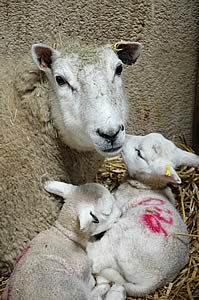06/02/09
With one third of all lamb losses in lowland flocks occurring during the neonatal period and a good proportion of these resulting from disease, it’s essential to maintain the best possible protection against infections around lambing this season’s, stresses Sorgene specialist, Shirley Wilson.
“First class lambing hygiene is one of the simplest, best and most economic ways of reducing the losses of life and vigour the major disease challenges facing newborn lambs so frequently cause. But it only takes a momentary slip amid the intense pressures of lambing management to let a range of serious infections take hold. Especially so where large numbers of ewes are lambing indoors within a short time.
“The particular vulnerability of lambs to infection is made worse by the substantial build-up of bacteria in housing and lambing sheds. Under these circumstances infections like watery mouth, joint and navel ill, clostridial disease and various types of enteritis can so easily take hold to cause serious damage. And, of course, for every lamb that dies there’ll be many more whose early performance is compromised.
“A modern broad spectrum disinfectants like Sorgene 5 proven effective against all major disease-causing agents even in the presence of severe soiling as well as safe to use around ewes and lambs offers just the sort of protection required at lambing,” she stresses. “But it must be used diligently as part of a well-established routine if it is to provide consistent and reliable protection.”
In particular, Shirley Wilson identifies five essentials of environmental hygiene at lambing that could make all the difference in combating neonatal infections this season:
- Thoroughly disinfect all accommodation before the start of lambing, pressure washing the sides and floors of the pens with a good quality detergent before spraying them with a broad spectrum disinfectant.
- Isolate sick ewes and lambs in specially-prepared pens well away from the healthy flock and tend them last to minimise cross-infection dangers.
- Wear clean overalls, dip boots in a broad spectrum disinfectant before entering the shed and wash hands with bactericidal soap before and after examining ewes and lambs or assisting with lambing.
- Keep a bucket of broad spectrum disinfectant on hand at all times to treat all lambing equipment, water bowls, teats and milk dispensers, making sure to refresh it regularly.
- Muck out pens frequently, replenish them with fresh bedding generously and disinfect exposed surfaces with a knapsack or hand-held sprayer at least daily.
“Good hygiene isn’t difficult,” insists Shirley Wilson. “But it’s all too easy to let your guard down when the pressure is on. So, use a proven disinfectant like Sorgene 5 at the correct dilution rate (1 part to 100 parts of water in this case) and follow our five simple rules throughout your lambing if you really want to minimise your losses this season.”
 Defra's Exotic Disease Cost Ambush Defra's Exotic Disease Cost Ambush
 Beef Farmers Face Win-Win Market Situation Beef Farmers Face Win-Win Market Situation
 New Scour Risk Assessment Initiative Aims to Cut Disease Costs New Scour Risk Assessment Initiative Aims to Cut Disease Costs
|



